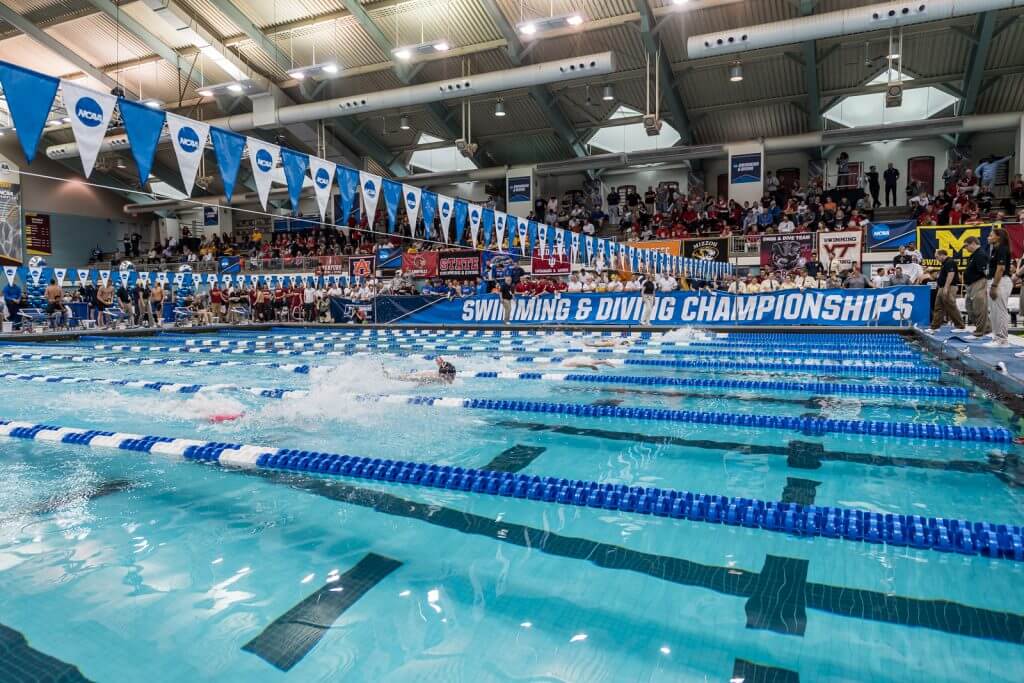NCAA Playing Rules Oversight Panel Approves 15-Meter Video Review Option in Swimming

Editorial content for the 2019 NCAA DI Championship coverage is sponsored by SwimOutlet.com. See full event coverage.

The NCAA Playing Rules Oversight Panel approved allowing the option of video review to determine whether 15-meter violations were called accurately in men’s and women’s swimming on Wednesday. The rule is optional and will go in effect in the 2019-20 school year. The rule will be used during the regular season as well as the conference and NCAA championships.
According to the NCAA release, meet committees will decide before competitions when video reviews will be conducted. All participants will be informed before the competition. All video reviews will be conducted before results become official.
The rule also states that the referee has sole jurisdiction over the review, and the referee’s decision is a judgment call not subject to further review or appeal. Only the referee and a conference or NCAA meet committee representative (who has no participating school affiliation) may view the video being used for replay review. Challenges by coaches are not permitted as part of this rule, and coaches are not permitted to view that video at any time.
A Long Time Coming
Swimming World challenged the notion for a revision on the rules for reviews of disqualifications in March after the Women’s Division I Swimming and Diving Championships. But this was after Michigan’s Siobhan Haughey was disqualified for a breaststroke pullout and Texas A&M’s Claire Rasmus was disqualified for turning on her back in freestyle. “This type of disqualification is based only on one person’s visual evidence that can often be impacted by poor visibility due to the rush of turbulent water and pool clarity,” Swimming World wrote at the time.
“More often, the visual lines are complicated by the reflective glare of powerful television lights illuminating each lane. Given the failings of the human eye, for one official to have supreme influence over a championship performance, based on singular visual evidence, is just wrong.”
Although the rule indicates it would solely be for 15-meter violations, this is a good start for the NCAA to implement video review for disqualifications. 15-meter violations occur when a swimmer fails to break the surface before 15 meters after the start or the turn. The release did not say if it would use video review other stroke violations.
USA Swimming and FINA have implemented video reviews and dual confirmation procedures in national meets since 2007 to ensure that any disqualification is verified.
According to USA Swimming officials, camera review has been used at every national championship meets since 2007, and has “saved a number of athletes.” According to USA Swimming, a call is made on the deck, it is radioed in to the review room with USA Swimming officials and technicians. They will confirm the call, overturn the call or let it stand if there is not enough video evidence to overturn. They can’t initiate calls. The Pan Pacific Championships have also used the technology since 2010.
Other Rule Recommendations:
Panel members also approved the process for calculating times when there is a primary timing malfunction so that they are more in line with USA Swimming and international swimming rules.
When a malfunction is confirmed on a lane, the backup times for that lane should be calculated as follows:
- If two of the three valid button or watch times agree, that should be the time for that timing system.
- In the case of three valid button or watch times disagreeing, the time of the intermediate button or watch should be the time for that timing system.
- If only two valid button or watch times are available, the time should be the average of those two buttons or the average of the two watch times. The digits representing thousandths of a second should be dropped with no rounding.
- If only one valid button or watch time is available, the time of that button or watch should be the time for that timing system, unless that time conflicts with other information.
Other rules recommendations approved:
- When divers tie in non-NCAA and NCAA championship meets for eighth place in the prelims of diving 1-meter, 3-meter or platform events, the tie-breaking method is to take all nine divers to the final. The consolation finals will have seven competitors in the event, none finishing higher than 10th place in the final standings. In the final, the nine competitors will do a six-dive list. The highest place finisher of the tied divers will remain in the place that they finished, while the other diver will place ninth.
- A minimum of two officials must be used for dual, double-dual, triangular and quadrangular meets. A minimum of four officials must be used for championship and invitational competition. The rule is effective for Division I for the 2019-20 academic year and 2020-21 for Divisions II and III.
- Lap counters will become optional and can be placed at the end or on either side of the pool.

- LIVE RESULTS
- LIVE STREAM (PRELIMS)
- LIVE STREAM (FINALS)
- PSYCH SHEET
- WOMEN TEAM INVITES
- WOMEN RELAY ENTRIES
- WOMEN DIVERS
- 2018 WOMEN'S NCAA RESULTS
- 2017 WOMEN'S NCAA RESULTS
- 2016 WOMEN'S NCAA RESULTS
- ALL COLLEGE NEWS
- OFFICIAL NCAA PAGE
- LINK TO 2019 MEN NCAA DI CHAMPIONSHIPS
- SWIMOUTLET.COM 2019 TECH SUIT REVIEW
- PREDICTIONS (PART 1)
- PREDICTIONS (PART 2)
- 2019 COMPLETE RESULTS




Why don’t we just eliminate humans and go to all video officiating. If we did that with video from above and under water for each lane I am sure there would be more infractions observed then there is currently. I for one and most of the other swimming officials I work with on deck will not make a infraction call that we do not CLEARLY observe.
Pfffft. You don’t know a ton of officials. The type that cheat, that is. I only hope that this video will be used to reveal those that use their positions to place themselves in the race. I’ve seen it at all levels and the sad party is that our isn’t a secret. Unfortunately, officials refuse to hold each other accountable by the same metric applied to swimmers.
You’re just rambling about nothing. You are an idiot. Officials are taught “ you don’t call something you can’t see.”
Amy Flint Howard and then maybe they’ll allow video review for some really good relay starts! ?